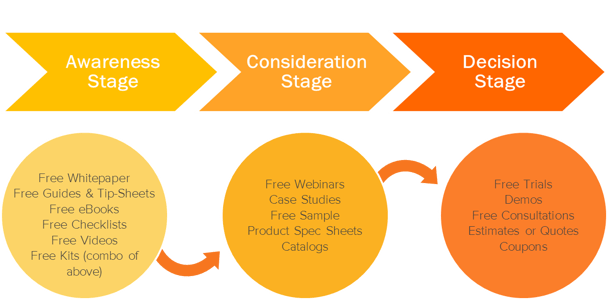THE COMPREHENSIVE GUIDE TO STAFFING AGENCY MARKETING
[FREE GUIDE]
This guide covers topics related to marketing your staffing agency to employers and candidates, with the ultimate goal of helping you get more visibility, better candidates, more leads, a higher volume of job orders, and more sales, faster.
Marketing to both employers and candidates means having a lot of balls in the air at the same time, at a point where marketing has become increasingly complex. Staffing agency owners are faced with a bewildering selection of approaches, tools, technologies, and the difficult task of making right-sized investments to balance the resources needed for simultaneously marketing to both targets.
We’ve prepared this guidance to help you find that balance.
It’s organized as follows, and you can read it from top to bottom, move to any section by clicking on one of the following links, or you can download the PDF version to save and access at your convenience.


DOWNLOAD: THE COMPREHENSIVE GUIDE TO STAFFING AGENCY MARKETING
Like what you're seeing but don't have time to read it all at once? Download the entire guide as a PDF directly to your inbox to read later, print, or share!
Growth Strategies and Models for a Staffing Agency
Any discussion about staffing agency or recruiting firm marketing needs to start with a discussion about growth models. The type of growth model (or models) you choose has a major consequence for positioning and mission statements, as well as for defining, designing, funding, and executing marketing objectives, strategies, and tactics.
For example, if your growth model is focused on mergers or acquisition, the marketing objectives, strategies, and tactics you’ll need to put in play will be completely different than those associated with a strategy of growing by adding new services or products.
5 Different Growth Strategies for Staffing Agencies and Recruiting Firms
Staffing agency owners and shareholders might consider using one or more of the following growth models or strategies. Building your overall business plan for growth will likely require a combination or variations of these strategies, depending upon your agency’s size, resources, ambition, and entrepreneurial skills.
Growth strategy/model 1: Deepen your agency’s market penetration and secure more market share
This is a basic growth strategy that’s likely to be found in every staffing agency’s business plan. However, most agencies reach a share plateau and have trouble moving up and forward because this is not an easy strategy to maintain once launched, and competitors will not stand still while you are stealing their share.
Your market penetration strategy could be built by focusing on a niche, (for example, IT or accounting) or by being the lowest price staffing provider in the market.
Growth strategy/model 2: Take your agency into new geographic markets
Another option or addition to your overall growth strategy is to open offices in new geographic markets, particularly if you have strong competitors in your current market that limit your growth opportunities. From a tactical perspective, options for executing a geo-market expansion range from carrying the weight (and costs) of opening your doors in a new location, to merging or acquiring another agency in a desirable location, to finding and developing a strategic partnership with another agency.
Growth strategy/model 3: Expand your current service line
This strategy is deployed by staffing agencies by offering variations on their core staffing services. For example, a recruiting firm could offer temp services, or a retainer-only firm could enter the contingent market. You might have a “preferred customer” service with a core of “first choice” candidates, or even create a service that
Growth strategy/model 4: Diversification
Diversification involves selling a new service to a new market that could be unrelated to your core business. There are not many agencies that have diversified into unrelated business, so we would not put this option high on the list of opportunities for growth.
Growth strategy/model 5: Merger and acquisitions
Growth through merger or acquisition is a strategy that every agency owner or shareholder needs to consider. However, this strategy is expensive, full of risks, and is no guarantor of success.
Duff and Phelps, a well-known independent advisor with expertise in the areas of valuation and corporate finance, says that “an increasing number of owners are seeking to capitalize on their current strong performance by realizing value through either a sale or recapitalization transaction."

Transaction activity will likely remain robust for the remainder of 2017 and into 2018…”
More Insights and Observations on Growth Models for Staffing Agencies and Recruiting Firms
You can find additional, more detailed marketing resources on growth strategies below:
Marketing Strategies for a Staffing Agency
Staffing agencies have the responsibility of marketing for both new accounts and exceptional candidates. There is a direct, connected line between these two needs, but they share the common objective or goal of growing the agency’s top line.
The Difference Between Objectives, Strategies, and Tactics
We often see a lot of confusion about what objectives, strategies, and tactics are, and the relationship among them. Each growth strategy you employ will have its own unique set of objectives, strategies, and tactics, so electing to pursue different types of growth models has consequences in terms of resources, technologies, costs, and more.
Here is our perspective on these terms:
Objectives: Quantifiable and measurable expressions of a goal, like “increase top line revenues by 10%." Your agency or recruiting firm might have two to four marketing objectives, and in your overall growth plan or strategy, you’ll need account-facing and candidate-facing objectives.
Strategies: Broad brush strokes of what you will be doing to reach goals, like “plan and execute lead generation campaigns,” which can be one of many strategies that can be employed for increasing top line revenues. An example of a candidate-facing strategy pursuant to an objective of growing a database of qualified candidates for a niche market by 5% can be something like “attend four to six trade shows."
In fact, each objective could have up to half a dozen or more strategies. Results for each strategy can be measured, and after tactics are identified, each strategy can have its own budget which, in turn, allows for a measurement of return on investment for a strategy.
Tactics: How you will bring a strategy to life. For example, “conduct a webinar on NLRB updates and use registration as a means to capture names and contact info” might be a tactic pursuant to a strategy for generating leads from account prospects. Every strategy will have some number of tactics, each of which might require funding, and each of which can be measured for results. Tactics are often confused with strategies (what vs. how), and are generally where extraordinary creativity comes into play.

5 Key Marketing Strategies for Your Staffing Agency or Recruiting Firm
An objective or goal of increasing the agency’s top line could have the following five strategies. We’ll also give a few examples of tactics for each strategy.
1. Increase Visibility and Brand Awareness
Whether it's sourcing for new candidates or growing accounts, if you don’t have visibility, the likelihood that you’ll meet your growth goals will be significantly degraded.
Tactics for more visibility to employers can include: paid advertising, blogging, SEO/keyword strategy, delivering presentations, participating in civic or trade associations, and more.
Tactics for more visibility to candidates gets into the realm of agency branding and how your brand is developed and presented, particularly in the social media sphere. You might also consider tactical ways to make more use of your ATS to reach exceptional candidates on a consistent basis.
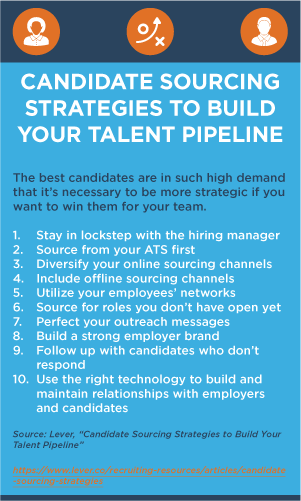
2. Source Exceptional Candidates
Without exceptional candidates to fill open orders, reaching growth goals will be difficult. Sourcing great candidates is also instrumental for building your brand and delighting clients.
From a tactical perspective, the bad news is that it’s likely that you and your competitors use the same channels to find and reach candidates – ATS, job boards, LinkedIn, etc. The good news is that entrepreneurs are constantly developing new programs and services that can give you a competitive advantage in finding candidates in a new ways.
Mighty Recruiter, for example, recently published a blog post called 2017’s Top Sourcing Tools That Can Help You Find Resumes Online that references seven sourcing tools that can help you unearth top talent and find resumes online.
3. Generate More Leads
An employer-facing lead generation strategy and lead generation tactics are “musts” for any staffing or recruiting firm. While many agencies enjoy the benefit of an abundance of over-the-transom job orders, aggressive growth oriented firms will want to develop and execute a proactive lead generation strategy and tactics that can capture a lead at any point on a buyer's journey. Chapter 7 of this presentation provides more insights on lead generation.
There are a wide variety of lead generation tactics, each of which require a “just right” combination of funding, creativity, and great execution to be successful. These can include offers for whitepapers, eBooks, checklists, free consultations, price discounts, and a lot more.
4. Close More Sales, Faster (Lead Nurturing)
Lead nurturing for staffing agencies is about having a strategy for building and maintaining a relationship with an account once the door has been opened. The sales cycle here is really the amount of time between initial contact and first job order, and then between a job order and a candidate placement.
From a tactical perspective, when it comes to opening the door to new accounts, you’ll need marketing technology — including a CRM with lead tracking capabilities, an email program built on a marketing automation program, and a content strategy that is personalized and comprised of non-advertorial and advertorial pieces.
Chapter 8 goes into lead nurturing in greater detail.
5. Maintain and Build Relationships by Delighting Current Clients, Candidates, and Referral Sources
Your existing clients are going to be your greatest source of new business, so it makes sense to have a separate strategy and series of associated tactics for maintaining and building relationships with them. You can also measure the effect of this strategy by tracking the number and frequency of job orders you receive, as well as tracking the engagement they have with your emails and premium content.
From a tactical perspective, this strategy can come to life through a combination of 1 to 1 interactions, plus delivery of your thought leadership pieces including webinars and whitepapers.
More Insights and Observations on Marketing Strategies for Staffing Agencies and Recruiting Firms
In addition to this guide, you can find additional, more detailed marketing resources on marketing strategies here:
Marketing Infrastructure for a Staffing Agency
Simply stated, without the right level of budget for the right tools and technologies needed for account-facing marketing and sales, there’s a high likelihood that your staffing agency’s growth plan will fail.
There’s a confusing and at times
Consider, for example, Martech’s recent “‘Martech 5000’ Marketing Technology Landscape” that revealed that almost 5,000 companies are now part of the landscape, a huge leap from the 150 itemized back in 2011.
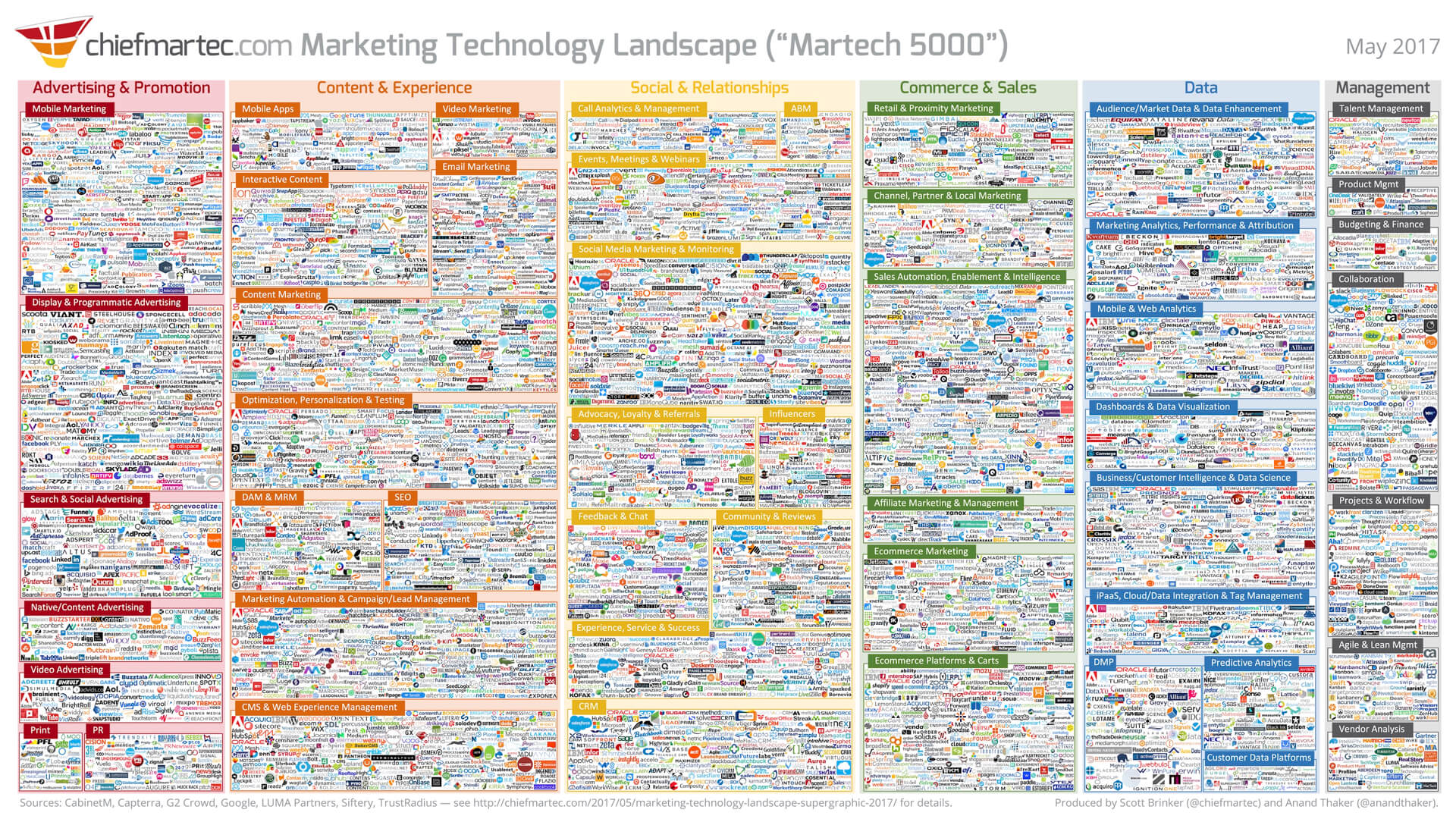
The number of choices is simply staggering, which is a prime reason that we recommend an all-in-one software solution like that offered by HubSpot.
Infrastructure for Opening the Door to New Accounts
There are seven categories of infrastructure for account growth that staffing agencies and recruiting firms need to consider as part of their growth strategy and plans:
1. Strategic Growth Planning Infrastructure
Planning is an essential and fundamental part of your infrastructure needs. This includes activities like defining quantifiable goals and objectives for new business dollars, new accounts, sales qualified leads, and website visitors. Planning addresses buyer persona profiles, positioning and mission statements, and competitive strengths and weaknesses. It establishes your SEO and keyword strategy, and much more.
2. Branding Infrastructure
Branding infrastructure includes costs associated with establishing a logo, brand standards, a corporate
3. Content Infrastructure
Today’s marketing requires that staffing agencies create and use a significant amount of different types of content for use at different stages of your buyer's journey. This can include a blog, case studies, podcasts, videos, whitepapers, and your website. It’s likely that of all the marketing items and actions in your budget, content will be the second largest line item.
4. Social Media infrastructure
Social media has become a “gotta have” for staffing agencies for both account- and candidate-facing marketing initiatives. Beyond establishing social media accounts on Twitter, Facebook, LinkedIn, Snapchat, and the like, costs for social media include the costs for the personnel you’ll need to populate and oversee all the social media channels you’re using.
5. Marketing Technology Infrastructure
As mentioned above, the landscape for marketing technology is growing at an almost uncontrollable rate, making it
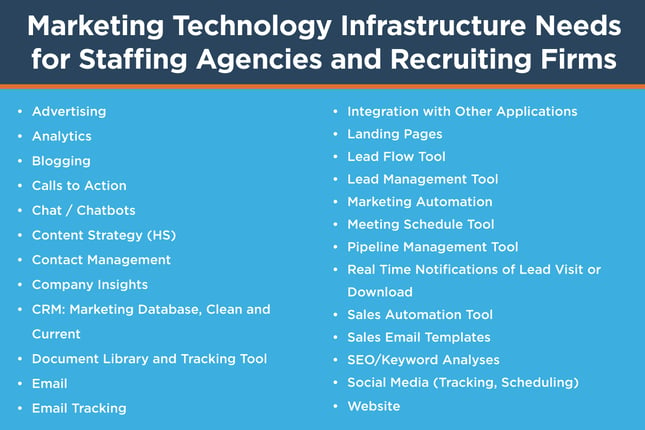
6. Human Resources Infrastructure
The largest line item in your growth budget will be people costs, and with a changing landscape of staffing agency marketing, so too will the landscape change when it comes to how you will be staffing your marketing and sales functions. Is it time for a Chief Growth Officer? Are you ready for a dedicated account team? Who will oversee and manage your social media?
7. Sales Enablement Infrastructure
Sales enablement will become more critical to the growth plans of staffing agencies and will require budget for items like a CRM, lead tracking, email templates, real-time lead notification, and more.
Candidate-Facing Marketing Infrastructure
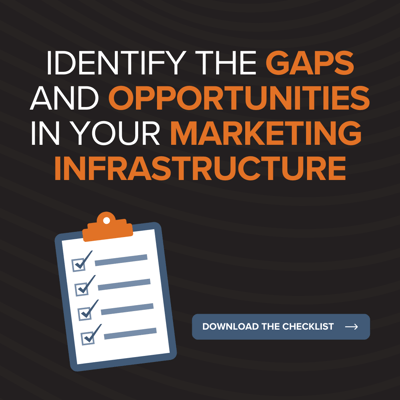
At the beginning of this guide, we talked about the need to balance the resources and costs of account- vs. candidate-facing marketing. While there are hundreds of ATS solutions and a huge number of different platforms and technologies for candidate sourcing, the heart of candidate facing marketing infrastructure may lie in (1) building your brand for positioning you as an agency of choice, and (2) using technology to nurture and maintain relationships with candidates, especially after presenting an opportunity.
For branding purposes, a consistent and well produced candidate-facing content marketing program with helpful content on the perils, promises, and processes of making a career or job change can work wonders. From a tactical and infrastructure perspective, delivering that helpful content using marketing automation technology becomes a mission-critical part of your agency’s character.
When a candidate is considering an opportunity you’ve presented, an automated drip campaign (with each drip illustrating a different feature or benefit of the opportunity you’ve presented) can be part of your infrastructure. In fact, you might find that these drips can be built around templates that require minimal personalization for maximum effectiveness.
More Insights and Observations on Marketing Infrastructure for Staffing Agencies and Recruiting Firms
In addition to this guide, you can find additional, more detailed marketing resources on infrastructure here:
Inbound Marketing for a Staffing Agency
Most recruiters and staffing agencies spend their marketing budget on outbound marketing to reach new account “suspects."
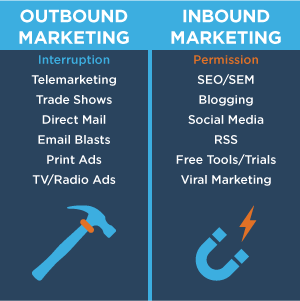 Outbound marketing, also known as traditional marketing, targets a broad audience using print ads, trade shows, telemarketing/cold calls, direct mail/e-mail, etc. Agencies push their messages outward in the hopes that it will trigger a response in the form of a contact.
Outbound marketing, also known as traditional marketing, targets a broad audience using print ads, trade shows, telemarketing/cold calls, direct mail/e-mail, etc. Agencies push their messages outward in the hopes that it will trigger a response in the form of a contact.
There’s a different and new way of getting more ROI from your agency’s investment in marketing and business development: inbound marketing
Inbound marketing is an approach to business development based
Inbound marketing involves implanting strategies and tactics for:
- “Getting found first” by potential customers who are searching online for solutions to their staffing problems
- Converting those who have found your agency into a new engagement with lead generation and nurturing tactics
- Transforming traditional outbound activities for more inbound traffic
- Continually monitoring and measuring results to refine tactics in order to deliver more ROI
At its core, rather than interrupting CEOs, CFOs, and business owners to get their attention with emails, cold calls, snail mail, and the like, inbound marketing relies on the principle that they’ll find and come to you if you have the right mix of online presence, thought leadership, infrastructure, discipline, and marketing technology tools like HubSpot in place.
Here’s a list of 12 “must-haves” for maintaining a successful inbound marketing program:
1. Optimized Website
Websites need to be engineered in order to “get found.” This involves a combination of having a keyword strategy, page configuration, great copywriting, and continually adding content through vehicles like blogging.
2. Blog
Blogging serves a number of purposes, from adding optimized content around keywords as part of a “get found first”
3. Content
One of the more challenging aspects of inbound marketing is having a continually fresh supply of content to populate blogs, white papers, articles, and so forth. Some agencies use a content publication schedule and assign authors, some outsource this function, and yet others employ a combination of outsourced and in-house authors.
4. Great Lead Gen Ideas
Lead generation is a combination of art and science, involving both left and right brain. It’s the hardest part of inbound marketing, requiring strategic thinking and planning first, and executions second.
5. Assignment of Accountability and Responsibilities
Marketing, sales, and leaders/owners need to be on the same page, each with a different set of responsibilities to make inbound marketing effective. Analytics will expose the hard, cold truths of who is (or who is not) performing their responsibilities effectively.
6. Landing Pages for Conversion
Once you get eyeballs to the website, you need to have an on-site mechanism to convert them to leads. This is done through landing pages, which serve to capture information and degree of interest of a prospect in exchange for a valuable piece of content or
7. Automated Lead Nurturing
Once an initial lead is captured, an automated lead nurturing program will be critical to moving that prospect through the sales funnel, from warm to qualified to
8. CRM
“Closed loop inbound marketing” includes a CRM system that “talks” to lead generation capture data, and serves to outline and record nurturing tactics.
9. Software for Analytics
Key analytics for inbound marketing include items such as keyword graders, sources of traffic, social media reach, lead gen campaign conversion metrics, site visitors, and more. There are many tools — a number of them free — that are available to these
10. Social Media Accounts
Social media accounts like Twitter, LinkedIn, and Facebook serve a few purposes — they can be used to promote thought leadership and drive traffic to the website for conversion to leads, and are keys to listening and responding to conversations that can lead to new business opportunities.
11. Backlink Strategy
A key part of getting found first is based upon search engine page ranking, and search engines like Google look to see how many other sites link back to yours as a measure of the site’s authority and credibility. This is a difficult and arduous task that takes time, but one that needs critical attention by marketing staff.
12. Outbound Marketing Infrastructure
Some of the eyeballs that come to your site will come through “organic” searches. Others must be driven to the site and, once there, converted to a lead. You need to reach those eyeballs with an outbound marketing promotional strategy that can include direct mail, email, pay per click, and so on. One critical part
More Insights and Observations on Inbound Marketing for Staffing Agencies and Recruiting Firms
In addition to this guide, you can find additional, more detailed marketing resources on inbound marketing here:
Content Marketing for a Staffing Agency
Content marketing is the art and science of converting the thought leadership of staffing agency owners, executives, recruiters, and other subject matter experts into materials that can be published, promoted, and shared. And when you get your content published, promoted, and shared, you’re filling the top of your sales funnel with account and candidate prospects that want see or hear what you have to say.
While some agencies and recruiting firms have been doing this in some fashion for quite a long time, new marketing thinking and tools like inbound marketing, social media, search engine optimization (SEO), and blogging are putting the need for a constant and consistent supply of fresh, relevant, and interesting content at the front and center of new business efforts.
Overview of Content Marketing Tactics for Staffing Agencies and Recruiting Firms
There's an ever-expanding number of content marketing tactics, from tried and true direct mail to the explosion of different social media channels that can be used to post and publish all manner of content and messaging. The sheer quantity of tactics poses dilemmas for staffing agency owners and marketers, but when it comes to selecting the right mix of tactics, a good rule of thumb is to select the tactic that brings you as close as possible to being able to “fish where the fish are.”
It makes sense to do some investigation and discussion with your clients and prospects about what types of content they like to consume, where and how they’re reading the content, and what they consider to be the most effective ways to reach them.
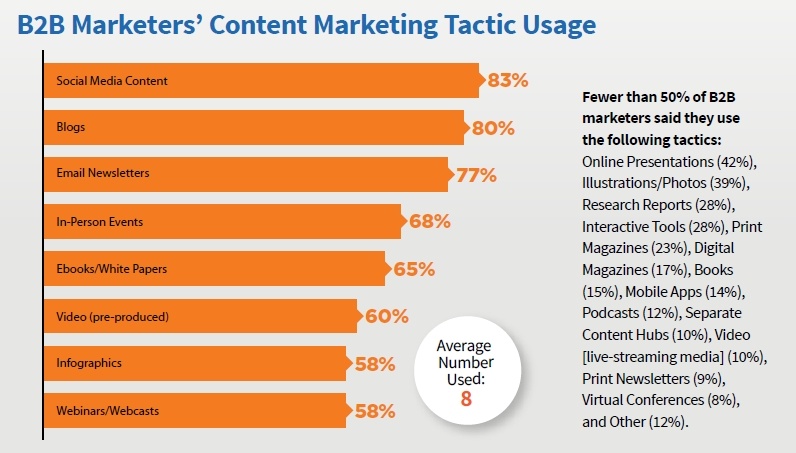 Source: Content Marketing Institute
Source: Content Marketing Institute
Contextual Marketing: Tying Content Marketing into Your Sales Cycle
Contextual marketing refers to online and mobile marketing that provides targeted communications based upon user information, such as the search terms they’re using, recent web-browsing activity, or demographic information captured via a form from a previous user experience on your website.
The goal is to present information and offers to customers representing products and services they are already interested in.
Contextual marketing has been developing over the past decade, and continues to become more specific as the Internet becomes more accessible and integrated. Meanwhile, a new type of contextual marketing is being developed around mobile devices, as more and more people carry such technology with them everywhere they go.
A well planned and executed content strategy is built to move prospects through your sales funnel. In fact, you should tie different types of content to different stages of the sales cycle.
One of the key mistakes that agencies make is sending content about services, pricing, and fees well before an account prospect is sales ready. This makes the firm appear to be sales aggressors, rather than thought leaders.
Finally, your agency needs an inventory of content to tie a content marketing strategy into your sales strategy, particularly if you employ an automated drip process for a lead nurturing campaign.
Sounds like a lot of work, right?
It is, but the ROI you’ll achieve is well worth the effort.
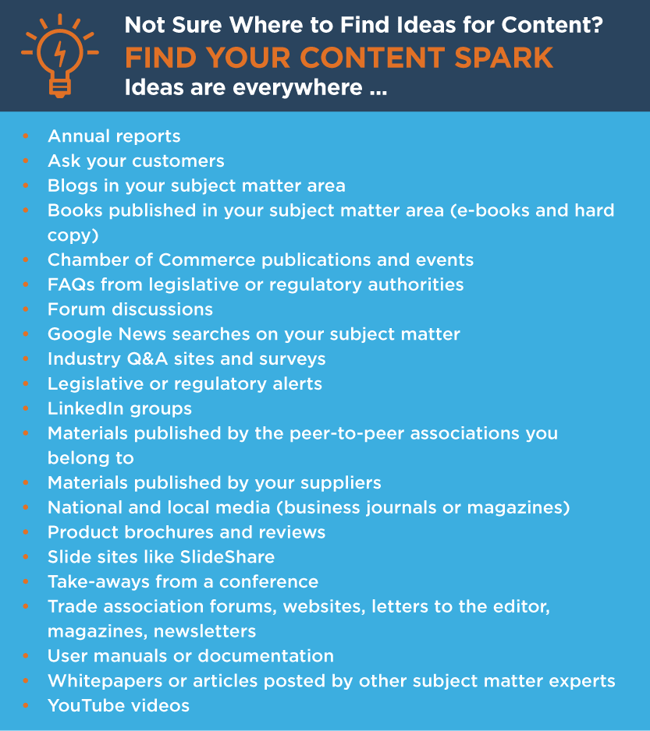
More Insights and Observations on Content Marketing Strategies for Staffing Agencies and Recruiting Firms
In addition to this guide, you can find additional, more detailed marketing resources on content marketing strategies here:
Lead Generation for a Staffing Agency
In the online universe, a lead is any individual who has responded to an offer your staffing agency or recruiting firm has made.
To convert someone from a prospect to a lead, they must take an action to make contact with your firm. This comes from filling out a form on your website. Once that prospect completes a form, they’re entered into a database and a CRM system. Then, over time, the relationship is nurtured with the goal of converting that prospect into a client.
There’s an important reason to use this definition. Most digital marketing analytics software products consider a lead in this fashion and build metrics and conversion statistics around this use of the term.
Here are the 10 "must-have" pieces for a staffing agency’s successful lead generation program:
1. Pain / Issue / Need
Lead generation campaigns need to be centered on a compelling pain point or issue faced by your prospects. HR related items that impact your prospects’ top or bottom line performance, new employment related legislation or regulation, competing for exceptional candidates, or micro- or macro-economic trends keeping them up at night are just a few examples of the types of issues that can be used to build a lead gen campaign.
2. The Offer
There are basically three types of offers you can present to prospects, each keyed to different parts of the buying process:
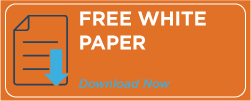
Top of the Funnel (TOFU) Offers: Designed to convert a site visitor into a lead using valuable educational (not advertorial) content,
A Middle of the Funnel (MOFU) Offers: Built upon the premise that a prospect with an identified problem will now turn to looking for solutions to that problem.
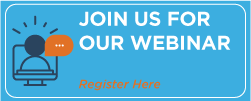
To influence prospects at this stage of the sales cycle, offers may come in the form of case studies, podcasts, solution comparison whitepapers, and so forth. Again, you’ll use a CTA and a landing page with a form to go after these conversions.

Bottom of the Funnel (BOFU) Offers: Intended to reach those prospects at the stage of the buying cycle where they will be making decisions.
This is the point at which educating a prospect about an issue stops, and educating them about your agency and why they should do business with you takes center stage. Your job is to convince them to hire you!
One of the best things you can do with your budget is to get a solid base of BOFU content ready to share — content that showcases your agency’s processes, skills, experience, and expertise.
3. The Device
Offers need to be packaged into a device, like a white paper, seminar, eBook, or report, just to name a few. Each type of device you might consider comes with its own unique set of logistical requirements (i.e., where do I get the information from and who’s going to write it?), and each will have indirect/resource and possibly direct costs. Also, different types of offers (TOFU, MOFU, BOFU) will use different types of devices.
4. Database
Lead generation involves both on-site and off-site promotion (outbound) to reach eyeballs for conversion to leads. A critical and challenging part of lead gen success is having a large and accurate database of account prospects — with email addresses — that represent opportunities to promote your offer and service.
List segmentation is an important part of the lead generation process. Basically, segmentation involves slicing and dicing your email database into various segments, and tailoring the content in your emails to those individual groups of contacts. Because your firm’s prospects are at different points in the sales cycle, or have different interests based upon their role in their company or organization, the objective of list segmentation is to reach the right prospect at the right time with the right message.
5. Call-to-Action Buttons
Essentially, a call-to-action (or CTA) is a banner, button, or some type of graphic or text on a website meant to prompt a user to click and continue down a conversion funnel. It is an essential part of inbound marketing as well as permission marketing in that it actively strives to convert a user into a lead and later into a customer.
6. Landing Pages
Your lead gen efforts need infrastructure for lead acquisition and capture. This is done through constructing a landing page in the background of your website where you can capture a visitor’s contact information and start the process of generating lead tracking and conversion metrics.
7. Off-Site Promotion

There are a variety of paid and unpaid media tactics you’ll want to consider and integrate into your lead generation campaign. These include paid advertising and unpaid tactics like promotion of your offers through social media platforms or your eNewsletter.
The centerpiece of off-site promotion should be email — it’s relatively inexpensive and produces the first set of metrics you’ll want to employ for measuring ROI. But social advertising presents a new frontier in staffing and recruiting lead generation. From sponsored content on LinkedIn and Google AdWords, to Facebook advertising and more, there are a variety of new opportunities for staffing firms to target and reach prospects in a cost-effective way, all while building brand awareness.
Even though these strategies are great in themselves to drive traffic to your website and content, a comprehensive digital strategy includes retargeting (or remarketing). Retargeting is a cookie-based technology that allows you to serve ads to people who have previously visited your site, helping you reach those who don’t convert right away without affecting your site’s performance. Staffing and recruiting firms on the bleeding edge of digital marketing are setting up automated social advertising campaigns through their CRMs and using retargeting to trigger ads that are appropriate to a prospect's stage in the buyer’s journey.
8. Metrics and Analysis
A significant part of the transformation in staffing and recruiting firm marketing is based on the quantity and quality of metrics that can be easily acquired. You’ll not only want to measure things like quantity of leads secured through a lead generation campaign, but also conversion metrics like visits-to-leads, landing page effectiveness, and the effectiveness of the various tactics you’ve deployed for promoting your offer.
9. Lead Nurturing and Automation
Since it’s likely that most leads you acquire through online lead generation campaigns will not be sales-ready, you’ll want to consider including a lead nurturing strategy as part of the campaign planning process. You may need three or more “touches” before a lead is sales-ready, and with the marketing technology that’s available today, this process can be automated and virtually hands-free.
10. Marketing Technology
There are many costs associated with online lead generation, including those for securing the right technology. You’ll want to consider using some type of marketing technology, like HubSpot’s all-in-one software that can help with the creation of CTA buttons, landing pages, email, automating the lead nurturing process, producing data for analyzing results, and more.

More Insights and Observations on Lead Generation for Staffing Agencies and Recruiting Firms
In addition to this guide, you can find additional, more detailed marketing resources on lead generation here:
Lead Nurturing for a Staffing Agency

Lead nurturing should be a critical part of the new business development strategies for any recruiter or staffing agency. Since most staffing engagements require the agency to always maintain top of mind awareness with clients and prospects, they need to be “touched” consistently over a period to move them to considering your agency for a search assignment — whether contingent or retained.
Maintaining a consistent presence on the desk and in the minds of prospects and clients can be accomplished via lead nurturing strategies and tactics, as discussed below.
Lead nurturing can be implemented through marketing technology that allows you to send an automated series of emails to either clients or prospects, at any point in their journey, leading to giving your agency a search assignment.
After a client is in your database, or after a prospect has made the move to interact with you by filling out and submitting a form on your website, automated lead nurturing is a low cost/high return way to maintain engagement. Further, if a client or prospect has stopped visiting your site or reviewing your offers, lead nurturing is a great way to remind them about your staffing services.
Reasons Why to Invest Marketing Resources into Lead Generation
There are five key reasons why investing marketing resources into lead nurturing as part of an inbound marketing program makes sense:
1. It allows you and the agency to stay top of mind. 66% of buyers indicate that “consistent and relevant communication provided by both sales and marketing organizations” is a key influence in choosing a solution provider, according to a Genius.com study.
2. Nurturing builds a relationship around thought leadership, not just sales messages. Lead nurturing is an opportunity to show that you are an expert in your field.
3. It keeps relationships timely. Nurturing reaches clients and prospects when they’re most interested in hearing from you.
4. Set it and (almost) forget it automation. Once set up, emails are sent out automatically according to your schedule as new leads come in.
5. Nurturing offers more precise targeting. Lead nurturing enables you to tie a series of emails to a specific activity or conversion event. In other words, you can craft your follow-up email based on the action a lead has taken on your website.
Lead nurturing isn’t about bombarding clients and prospects with sales messages. It’s about moving them through the sales funnel until it’s appropriate to discuss your services, products, and pricing, leading up to a job order and ultimately, a new sale. You start out by sending useful, low-commitment information with content-based calls-to-action, gradually leading to that all-important discussion about engaging your agency.
 Source: “The Ultimate Page of Sales Statisitics,” IneOPage CRM
Source: “The Ultimate Page of Sales Statisitics,” IneOPage CRM
Lead Nurturing is for Candidates, Too
With competition for candidates at an all-time high, it makes sense to nurture the “assets” you currently have in your tracking system. Your goal includes the ability to reach the right candidate with the right opportunity, as well as to create a relationship that can very well tip the scales in your favor if a candidate is working with several different agencies.
Automated lead nurturing in this case would be built on delivering your agency’s thought leadership on topics that could range from salary surveys to interviewing guidance and tips. You could, for example, schedule once a month emails with helpful advice and guidance, as well as links to open positions. By doing so, you appear on the candidate’s radar screen with more than just a sales-like notice of a job opportunity.
In effect, you become the candidate’s helper, and in the process, establish a relationship and build your brand.

How to Set Up a Lead Nurturing Campaign
Setting up a lead nurturing campaign includes the following steps:
- Get automated technology and infrastructure in place (i.e. HubSpot).
- Determine your goals, which will direct your entire campaign: audience, content, and success metrics.
- Select a persona. Decide who you are trying to reach and what problem you are helping them solve. This can be either a candidate or a hiring authority.
- Re-purpose existing content. Choose which content you should send to your contacts in your database both employers and candidates.
- Set up a timeline. Your agency has a typical sales cycle, and so should your lead nurturing campaigns; typically, it’s a good idea to send two to three emails to your prospects in a lead nurturing campaign.
- Measure improve. Make sure you know what’s working and what’s not so you can continue to improve.
More Insights and Observations on Lead Nurturing for Staffing Agencies and Recruiting Firms
In addition to this guide, you can find additional, more detailed marketing resources on lead nurturing here:
Sales Enablement for a Staffing Agency
Sales enablement is all about closing more sales, faster. Being proficient with the combination of processes, technologies, and strategies and tactics that are the key components of sales enablement doesn’t mean that you’ll be filing job orders faster… it means that you’ll be better and more effective at bringing new accounts to your agency that represent the opportunity for securing job orders.
In this case, a “closed sale” is more akin to opening the door for opportunities than it is to selling a product. Regardless, the fundamentals of sales enablement success include being able to align your agency’s sales and marketing resources and get them on the same path towards a single minded goal of top line growth.
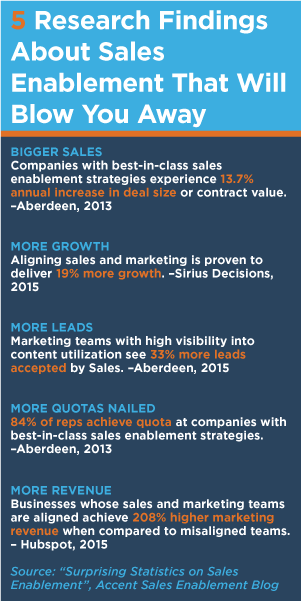
Critical Signs that Your Staffing Agency May Need Sales Enablement
Regardless of whether your staffing has a sales team/department, sales are principally being done by the owner, or your recruiters have dual account-facing and candidate-facing responsibilities, sales enablement strategies, tactics, tools, and technologies may be the ingredients necessary for growing your top line.
Here are a few signs that a discussion about sales enablement is appropriate:
- Blaming and finger pointing because marketing and sales teams don’t work well together
- Identifying what marketing resources are producing results is difficult
- Identifying what sales assets are driving results is difficult
- It takes too much time to onboard sales reps
- Missed revenue goals
- New content and collateral prepared by marketers is unused and sitting on the shelf
- Prospects are getting stuck in your sales pipeline
- Sales reps are not staying in touch and building meaningful relationships with prospects
- Sales reps are spending too much time customizing proposals
- Sales reps are spending too much time looking for the right content to send to prospects
- Sales reps aren’t using the right content at the right time
- Using a one-size-fits-all approach to sales
Infrastructure Your Staffing Agency Needs to Do Sales Enablement
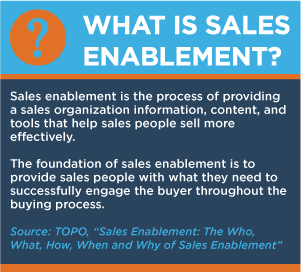 While sales enablement starts with your good intentions to make improvements, you will still need to invest in a new way of thinking as well as different tools and technologies.
While sales enablement starts with your good intentions to make improvements, you will still need to invest in a new way of thinking as well as different tools and technologies.
Here’s a brief list of the infrastructure required:
- Clear definition and identification of your agency’s target market(s) and the psychodemographics of those markets
- Quantifiable goals and objectives that both the marketing and sales team help to develop
- An agreement and alignment between marketing and sales teams on the definition of Marketing Qualified Leads and Sales Qualified Leads
- Defined accountabilities and responsibilities for personnel in marketing and sales functions, including owners and partners
- Repeatable processes for lead handling and handoff
- Relevant content and sales collateral for every stage of the prospect’s journey through your sales funnel — both account- and candidate-facing
- Multi-functional CRM including deal dashboards
- Marketing automation technology for drip campaigns
- Real-time notifications of email opens and clicks
- Email templates and sequences
- Automated meeting setting software
More Insights and Observations on Sales Enablement for Staffing Agencies and Recruiting Firms
In addition to this guide, you can find additional, more detailed marketing resources on sales enablement here:
SPECIAL BONUS CHAPTER: How to Build a Brand for Your Staffing Agency That Attracts the Best Quality Candidates
In a world where staffing agency owners stay awake at night because there are not enough good, qualified candidates to fill their job or contract orders, the necessity to have a strong agency brand has never been greater.
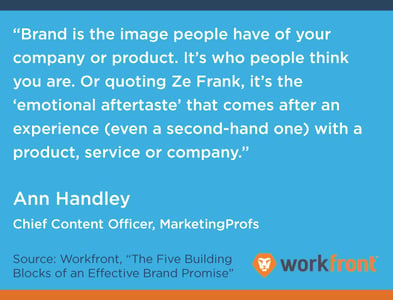 Strong brands attract strong candidates. They serve as competitive differentiators. A strong brand drives inquiry from candidates, employers, and referral sources. A brand can be the basis for meaningful and long-lasting bonds of loyalty and trust with stakeholders of all types. Your brand provides direction and motivation for your staff. And finally, a strong brand identity can be a rationale for commanding higher fees.
Strong brands attract strong candidates. They serve as competitive differentiators. A strong brand drives inquiry from candidates, employers, and referral sources. A brand can be the basis for meaningful and long-lasting bonds of loyalty and trust with stakeholders of all types. Your brand provides direction and motivation for your staff. And finally, a strong brand identity can be a rationale for commanding higher fees.
The great marketing strategist Phillip Kotler was spot on when he said that if you are not a brand, then you’re a commodity.
In an era where good quality candidates are fielding multiple inquiries or offers, or where they’re hidden from view, or reluctant to engage with your recruiters, being a commodity just won’t cut it. Your brand image, reputation, and the brand experience you deliver will be the difference between more qualified candidates, more satisfied customers, and more growth in revenues and profit.
Benchmarking Your Brand with a Candidate Net Promoter Score
Branding your company to candidates begins with a simple truth: candidates are customers. This truth is a foundational piece when it comes to building your brand, as all of the touch points of a candidate’s experience with your agency — from how you appeared on their radar screen, to your hiring processes, to the interactions they have with your recruiters — relate to what candidates think about you, and in turn, your brand identity.
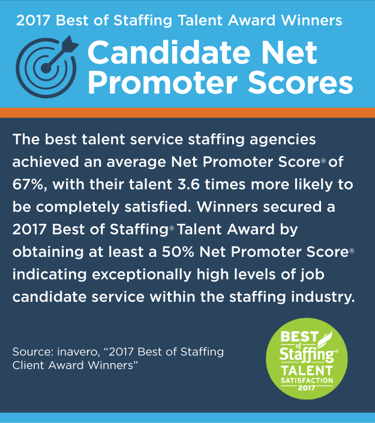
To build your brand, consider starting with a benchmark — your “Candidate Net Promoter Score.” This is a number based on a scale of 1 to 10, where after going through your recruiting process, candidates are asked how likely they are to recommend your company to a friend or colleague. The average percentage of candidates giving a high ranking is subtracted from the average giving the agency a low ranking to arrive at a net score.
This is done via a survey that you can do without any outside assistance, and many firms take the opportunity to dive deeper on candidate responses with follow up questions that generally ask, “why do you say that…?” This deeper dive delivers insights you can use to promote your brand, or identify and fix what’s wrong.
Staffing Agency BrandWheelTM - Building Blocks for Creating a Brand That Candidates Love
There are at least 8 different pieces you’ll need to put in play to build a sustainable, meaningful, and impactful brand for your agency or recruiting firm.
Many of these will require an investment in marketing infrastructure, others may require a cultural shift, and others deal with new roles and responsibilities of management and staff. If at first blush this seems overwhelming, bear this in mind: building a brand is a marathon, not a sprint.
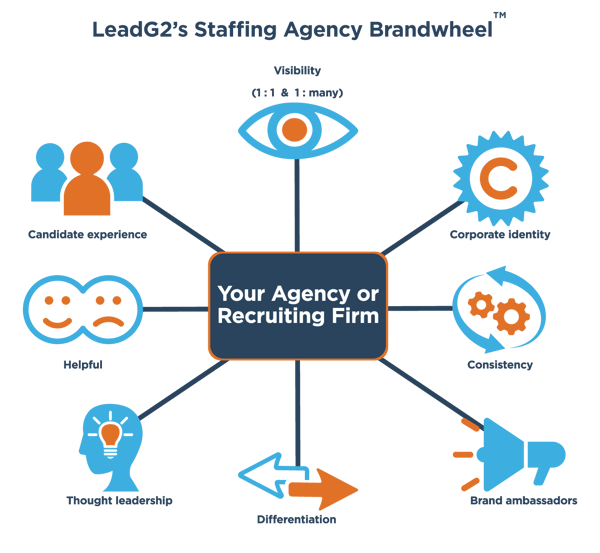
Visibility and Brand Ambassadorship
Visibility for your staffing agency or recruiting firm is an obvious way to build a brand, but unlike consumer brands, it’s not as cut and dried as just spending a lot of advertising dollars in a lot of different places and in a lot of different ways (although we do strongly believe that paid media needs to be part of your visibility equation). Many of the chapters presented above are ripe with guidance on the strategies, tactics, tools, and technologies for getting visibility and generating leads in a digital environment via paid, earned, and owned media.
Less attention has been given to 1:1 interactions for increasing visibility as part of branding. Every time a recruiter interacts with a candidate is an opportunity for that recruiter to be an ambassador for your agency’s brand. You can teach your staff how to be brand ambassadors, and there are companies like Brand Integrity that design inventive programs for staff that reinforce the importance of their role in building the reputation and brand of the companies they work for.
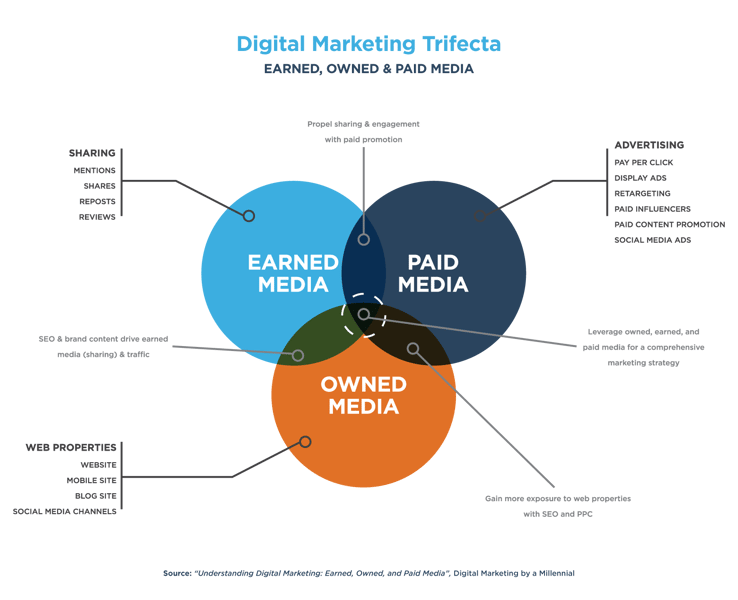
1:1 brand building includes building relationships and networks, and perhaps more importantly, maintaining those relationships. That’s where digital marketing in the form of marketing automation and social following and engagement is important.
Visibility includes using traditional marketing to candidates to build your brand. There’s nothing wrong with print advertising, direct mail, sponsorships of events at trade associations, using specialty advertising promotions, or having a strong community relations program to build a brand. Somehow, amid the love affair marketers have with digital marketing, they’ve forgotten that the impact of delivering one speech to one audience composed of their target market persona can do more for building their brand than dozens of blog posts.
In other words, your brand building plan needs to include marketing department efforts to secure opportunities for presentations delivered in front of live audiences.
Candidate Experience
Nothing will ruin your staffing agency’s brand faster than a bad candidate experience, especially when social sharing is now the norm. Your Net Promoter Score can serve as a benchmark for gauging candidate perceptions, and a pathway to discovering how, when, and why you may need to make improvements.
In fact, TargetRecruit in the Recruiting Brief says that improving candidate experience will be a top trend in 2018 and beyond.
There are many different touch points for a candidate to experience your agency: sourcing, recruiting, application processes, interviewing, and interpersonal communications are just a few of the ingredients that will drive a candidate’s perception of your agency, and in turn, perception of your brand.
Have you walked a mile in your candidates’ shoes?
Thought Leadership: Always Be Helpful
More and more, staffing agencies are turning to content marketing to get more visibility, leads, and great candidates. Whether coming in forms like blogs, videos, infographics, or even podcasts, candidate-facing thought leadership consumes an ever-increasing portion of marketing budgets and resources.
We’ve presented a lot of our thought leadership about content marketing above.
When content marketing is helpful — not advertorial — it also serves to differentiate your staffing agency while concurrently building your brand. Getting candidates returning to your website time and time again to get information, insights, or guidance is a powerful way to create a relationship that can serve you and your customers well, while giving a candidate an experience of your brand that goes far beyond just a list of available openings they can find in many different places.
 Differentiation
Differentiation
Differentiation is essential to building a brand, as lookalike and sound-alike agencies give candidates nothing more than background noise in their pursuit of a new career opportunity. Pinpointing your differentiating factors and using them to build a candidate-facing positioning statement for your staffing agency helps candidates immediately understand if you are the right fit.
There’s a vast number of ways that you can differentiate your firm, and a prudent spend of your marketing budget may be to hire a qualified marketing strategist to help you discover not only what your differentiating factors are, but also which of those factors are meaningful to candidates.
Then, you can put that differentiation into a positioning statement, train your staff, and use your communications channels to deliver your message to the market.
Corporate Identity
Corporate identify refers to the visible elements of your brand — logo, slogan, colors, and their execution in vehicles like websites, banners, envelopes, labels, business cards, and the like. Unfortunately, many staffing agencies believe their brand building starts and ends with corporate identify executions but, in truth, they’re probably the last element in a long line of other needs that are part of the makeup of a strong brand.
Many years ago, an educator named Lawrence Peters wrote a book called “The Peter Principle” that contained this oft-repeated quote: “An ounce of image is worth a pound of performance.”
This quote provides insight as to why agencies tend to put more resources into designing beautiful websites than they do into improving candidate experiences, creating brand ambassadors, or publishing helpful thought leadership — elements that in our opinion are a whole lot more important for brand building than image alone.
Budget and Infrastructure
Staffing agency brands fail to launch or reach their intended objectives because of shortsightedness when it comes to making investments of time, resources and budget to acquire infrastructure or spend on brand development and promotion.
Click here for a Marketing Infrastructure Checklist that provides an easy to use guide to assess pas in your infrastructure that relate to necessary spending for building a staffing agency brand.
Virtually every spoke on the LeadG2 BrandingWheelTM requires budget. Traditionally, we think that our budget for branding needs only be used for creating new websites or other corporate identity elements, but the message of the BrandingWheelTM is that it’s important to think (and spend) beyond vanity marketing to create and sustain a brand.
Take away a spoke, and the integrity of the wheel gets compromised, and eventually, the wheel collapses.
Of course, you can prioritize spending and we strongly recommend that you do so, using data from your Net Promoter Score to help you identify gaps or weaknesses your agency may have.
Consistency and Persistence are Critical for Building Your Staffing Agency or Recruiting Firm’s Brand
Finally, building a brand for your agency requires patience, persistence, commitment, and resources. You need to think, live, and act your brand over the long term, consistently, but you can prioritize the order of the steps you need to take on your journey.
Brand building involves a lot more than “one and done” lead generation tactics or peaks and valleys in brand build spending. You’ll have a good idea of whether you’ve been successful in building your brand when you achieve a Net Promoter Score in the 60s or above, but don’t be discouraged if it takes some time to get there.


DOWNLOAD: THE COMPREHENSIVE GUIDE TO STAFFING AGENCY MARKETING
Like what you're seeing but don't have time to read it all at once? Download the entire guide as a PDF directly to your inbox to read later, print, or share!
.png?width=2250&height=647&name=LeadG2-logo_(2).png)
